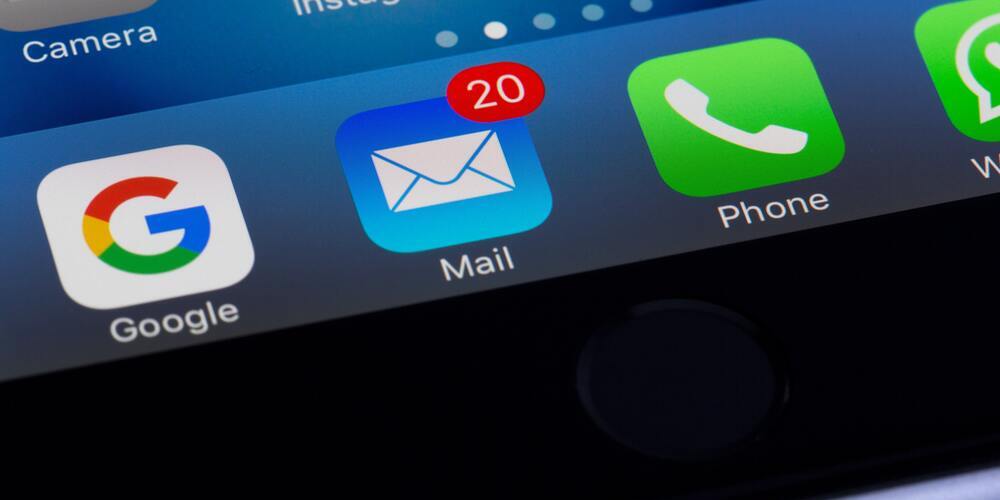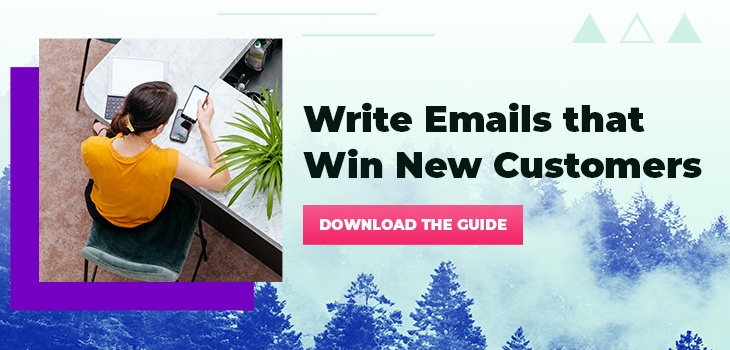Email marketing can feel like it's a waste of time because of your own experiences, e.g., sifting, archiving, swiping left, marking as spam, etc. But think about the companies whose emails you look forward to or products you enjoy. Those are the emails that never get lost in your inbox and are the emails you open and engage with.
Yes, some customers just show a single click-through or only make one purchase. Still, for new customers and returning customers, they want to engage with your email campaigns and want to continue to hear from you — whether that be for the love of your content or promotional emails, they'll continue to come back. Let's face it, wouldn't we all like to save 15% on that new blender we’re about to buy?
In this article, you'll learn not only why email marketing is still relevant for 2023, but why an email marketing strategy is more critical than ever before.
👉 Download the Sales Funnel Toolkit and get everything you need to plan your next nurture series and lead magnet.
You'll learn:
- Owning Your Audience
- Engaging experiences: Win potential customers and win back past customers. (work smarter, not harder).
- Personalization: Creating more meaningful customer relationships.
- Engaging your contacts: Simple & cost-effective.
- A/B Testing: Gain valuable insight into your marketing efforts.
- A fluid buyer's journey: Connecting your marketing channels.
- Unpacking: The importance of email marketing.
Let’s get to kicking off your email marketing game and crushing your goals this year.
"Own" Your Audience
First up is one of the biggest reasons email marketing is still so important — you have control over your email list. There's tons of opportunity to build an audience on social platforms like LinkedIn or Instagram these days. But what happens when those platforms change or even when they go down?
You don't want to lose the audience you've spent so much time and effort building. That's the first and biggest reason email marketing is still important, because those contacts live in a database you "own" and control.
Engaging Experiences: Win Potential Customers and Win Back Past Customers
Chances are you have a "SIGN UP TO SUBSCRIBE TO OUR AMAZING NEWSLETTER" or "STAY UP TO DATE ON THINGS YOU PROBABLY DON'T NEED" call-to-action plastered somewhere on your website. But what does the experience look like once someone has taken the bait?
Do you use email to deliver a witty, charming introduction to your business, all while creating brand awareness? Have you set up an abandoned cart series to snag that potential customer who may have just forgotten to click "PAY"?
Never miss the opportunity to win back an abandoned cart or engage new leads with email automation.
Trigger an immediate follow-up email after a user has abandoned their cart as a reminder of their left-behind products and ask if they need further assistance in completing their purchase. Or, enroll a new subscriber into a four-part welcome series outlining the five fantastic reasons why [insert snazzy product name] is different from the rest and how to learn more about said snazzy product.
Effective email automation converts missed opportunities into opportunities for stronger customer relationships and increased conversions.
Let it be your best friend in developing the infrastructure for experiences at every stage of the buyer's journey: awareness, consideration and decision. Sooner than later, you'll begin to reap the benefits of email marketing automation with more engaged and higher converting contacts.
You may think prospective customers will give you the highest return on investment, however, your returning customers are your biggest source of revenue. A returning customer has already bought into your brand, and half the battle of winning them over has already been won. Now, it's a matter of building a continuation of their journey to keep them coming back as loyal brand ambassadors.
Run an eCommerce platform?
Social media marketing or paid advertising, even direct mail (yes, good ole snail mail), can work for product promotion. But the truth is, 77% of people would rather receive permission-based promotional messages via email. Contacts have explicitly permitted you to send them communication directly to their inbox, which means they want to receive your promotional emails. Additionally, correctly timing your emails (utilizing platforms like Seventh Sense) will yield a higher open rate, click-through and conversion rate.
Other digital marketing tactics can be disruptive to the customer's journey and will not return the same level of engagement.
True, you could find yourself in a deep rabbit hole of building customer experiences if you're not careful. So start with the basic types of email nurture series:
- Welcome Series
- Nurture Series
- Abandoned Cart (if applicable)
- Re-Engagement Series
Starting with these will give you some heavy-duty ammunition to build out your customer experiences. Tactics like segmentation, personalization and tracking customer actions will open your eyes to other potential email automation strategies.
👉 Read: 5 Email Nurture Sequences to Convert Prospects
Personalization: Creating More Meaningful Customer Relationships
What are you really doing when you personalize and customize your email marketing campaigns for your target audience? You’re marketing smarter, not harder. Personalization increases your return on investment, engages customers in a more meaningful way and allows you to be more agile in your email marketing tactics.
71% of consumers say a personalized experience would influence their decision to open and read brand emails. Who knew, using someone's name instead of "Hey there!" or "Hi friend" would be so impactful?
Utilizing personalization tokens to create what feels like a one-to-one experience should be a standardized practice. It doesn't even have to be the use of someone's first name!
![]() Take, for example, an email from my favorite wine subscription (shelve your judgment, it's one of the most revolutionary services). They display my credit balance in the preview text of every email, e.g., "You have $80.00 in credit").
Take, for example, an email from my favorite wine subscription (shelve your judgment, it's one of the most revolutionary services). They display my credit balance in the preview text of every email, e.g., "You have $80.00 in credit").
Does seeing how many credits I have available to put towards a case of wine entice me to want to shop? You're 100% right it does. Who wouldn't want to know they have $80.00 available in affiliate credits to spend on wine? It's wine, people!
What else do I mean by personalization? Take things one step further to becoming more intentional with your email marketing efforts — start segmenting your contact list based on specific contact properties or actions your customers have taken.
For example, HubSpot affords you the ability to track page views. Say you want to target contacts who have viewed a product page multiple times with a follow-up email. Clearly, if a contact is viewing a page more than two, three, or even five times, they have intent towards that product or service. Here are a few quick steps you can take to engage those contacts viewing the product:
- Create a list using the number of page URL views as criteria
- Build a nurture series to funnel contacts from this list into a three- to six-part follow-up email automation series
- Create if/then branches based off email engagement, actions outside email engagement or un-engagement
- Write custom email content for each level of engagement and segmentation
These simple steps can build you numerous segmentations to then further divide or exclude from future marketing campaigns. Turn things up another notch and learn how to expand on your email lists with blogs, opt-in strategies and more.
If you're not already utilizing personalization and customization within your email campaigns, it can feel like the Marley Brothers, from The Christmas Carol, rattling their chains late at night, haunting you for all your personalization wrongdoing.
So let's cut those chains and in the wise words of Nike, "Just do it."
👉 Also relevant: Content Marketing 101: How to Build a Digital Content Strategy
Engaging Your Contacts: Simple & Cost-Effective
Ballin’ on a budget? Get to sending some emails! With the ever agile field of digital marketing, one thing is consistent — the need to maximize your marketing budget.
When you look at paid advertising (both print and digital) and realize the thousands and tens of thousands of dollars that go into those marketing campaigns, email seems like a no-brainer. As one of the most cost-effective marketing tactics, it's time to start reaping the benefits of email marketing.
A joint study from Shop.org and Forrester Research found that 85% of US retailers already recognize email marketing as one of the most effective customer acquisition tactics, especially for start-ups and small business owners (SMBs). In fact, for every $1 spent on email marketing, the average return on investment is 122%.
Practicing proper list usage and maintenance, in combination with your email marketing, will also aid in your overall cost and benefit your ROI. As you establish more personalized relationships with your contacts, engagement will increase along with conversion rates and email subscriber retention simultaneously decreasing the cost per email. (By the way, if you're looking for a breakdown of the email platforms out there, check out this helpful guide from QuickSprout).
All this said, it's not so simple as writing some copy, putting together some graphics and sending it off with fingers and toes crossed your open rates, click-through rates and conversions skyrocket. Writing an email with compelling subject lines and captivating content takes work.
What's that I hear? Was that a resounding echo of the A/B testing superpowers here to help contribute to budget optimization, customer engagement and return on investment?
Too cheesy? That's okay; I fully accept the cheese in the name of testing. Plus, I love a good cheese plate. We digress.
A / B Testing: Gain Valuable Insight Into Your Marketing Efforts
A/B testing with your email marketing is like butter on toast, two peas in a pod, cheese and macaroni (anyone else getting hungry?). Harness the power of customer data to know exactly how your target customer will respond to your emails.
You may not realize it, but the emails you receive in your personal inbox are more than likely contributing to the metrics in a more extensive marketing study. Our inbox habits and actions are being analyzed from the second we receive an email to the minute we click on a link in an email, and beyond. Okay, I'll get off my "big brother" soapbox, as I'm sure now you'll think twice before opening the next marketing email you receive.
Given the bandwidth, testing should be well integrated into your marketing efforts. You'll unlock the answers to a multitude of questions like:
- Do your emails receive higher open rates with emojis in the subject line?
- Do click-through rates increase with HTML or plain-text emails?
- Do unsubscribe rates increase with fewer or greater images/graphics?
- Do your email subscribers respond to emails sent earlier or later in the day?
- Which send-from address increases open rates?
If you don't know the answer to these questions, a testing Jedi you too can become.
So, you've started testing, what happens once you begin implementing various hypotheses? You'll fail. Okay, that may be a little harsh, but the truth is 50-60% of the tests you run may not return any results. That being said, these are not failed tests.
Every "failed" test is still an opportunity to learn. Maybe open rates stayed the same when you started using emojis in your subject lines. Great! You can conclude your customer base shows little to no response, and this isn't a marketing tactic that works to stand out in inboxes. Or emojis should be used sparingly and only for important emails for the most significant impact.
Another scenario? Maybe 75% of your customers open your emails on mobile and your click-through rates take a dive bomb when you start incorporating more copy. Give the people what they want, more images and graphics!
And testing shouldn't end either just because you notice common trends early on with your email marketing. What you learn today doesn't mean your customers will demonstrate the same habits in three years or even one year from now. Continuous testing contributes to the theme of "work smarter, not harder," allowing you to be more precise and intentional with your email marketing.
The customer data you collect through your testing efforts will help you learn how to customize your marketing messages, create engaging content and increase your ROI.
Bottom line, for all you data-driven marketing nuts like myself, testing will become a natural part of your thought process and marketing efforts.
A Fluid Buyer’s Journey: Connecting Your Marketing Channels
It's time to bridge the gap between your marketing channels. What's the use of shelling out the big bucks for paid advertising to capture leads if you have no follow-up strategy?

The truth is, your other channels function to speak to a varied audience. Sort of like dropping a fishing line into open water to see what you come up with. When your target customer begins to emerge from social media marketing, SEO, content marketing, etc., what's next for that audience?
Say you've created a post for social media that drives to a landing page with a call-to-action and a prospective customer submits their email through the call-to-action. What happens next? Ideally, this customer falls into a series of email messages that nurture them to create brand awareness. They receive timely emails that direct them to related content on the website, information about new products/services and other varied touch points that ultimately result in a conversion.
Don't believe me? Just take a look at the stats:
- Organic reach is around 4x higher on email than on social media
- Email generates $38 for every $1 spent, which is an astounding 3,800% ROI, making it one of the most effective options available.
- Marketers who use segmented campaigns note as much as a 760% increase in revenue.
- Click-through rates are 100.95% higher in segmented email campaigns than non-segmented campaigns.
Okay, okay, I'll stop!
Email marketing tools provide you with the ability to create a fluid, interconnected and undisrupted buyer's journey. More importantly, email marketing allows you to build relationships with leads, customers and past customers. It's your opportunity to speak directly to them in their inbox, at a time that is convenient for them.
Coupled with the right messaging, email can become one of your most impactful marketing channels.
Mobile Talk: Email Marketing on Mobile Devices
Did you know that according to Google, mobile users check their email 3x more daily? Or that 70% of people read their email on a mobile app?
In 2019 alone, 63.4% of web page views were on mobile devices. Can you imagine the next five years? May the marketing gods have mercy on you if you ever forget to consider mobile devices with your email marketing.
Reading these statistics, it's not hard to imagine why reaching consumers on their mobile devices and ensuring your emails are optimized for mobile devices, is so critical. Think about how much easier is it for someone sitting on the couch to watch TV while they online shop, catch up on email, view their social media, etc. on their phone versus on their computer?
Also, keep in mind, the shift away from physical remote controls. People are using remotes sparingly with the rise of streaming service apps. Gone are the days of digging through couch cushions to find lost remotes, here are the days where our phones are permanently attached to our hands. This means more time spent on mobile and the increasing importance of being top-of-inbox so that for one of the three daily inbox checks, your email is seen.
More important is mobile device optimization. Within three seconds of someone opening your email and deciding if it's a good mobile experience, you will win or lose. You can have the most engaging content in the world, but if the user decides it's a less-than-stellar mobile experience, POOF, your email will be history. Even worse, the user might unsubscribe or mark your email as spam.
Here's a quick hit list when checking your email for mobile responsiveness:
- Adding alt text
- Properly sized images
- Use buttons instead of inline CTAs for a better UX
- Evenly proportioned text in combination with images
- Refraining from using multiple column layouts, unless created with a responsive template
Email can be an incredibly powerful channel with greater accessibility than social media channels like Twitter (a tweet remains relevant for about 18 seconds before disappearing into the abyss of Twitter). Couple mobile responsiveness with your email marketing campaigns and you've got an award-winning combo.
Unpacking the Importance of Email Marketing
If you've read through this novel of an article, likely you're feeling a little bit like this. [I'll take every chance I can to add a Ryan Reynolds GIF]
So, let's unpack a little:
Why is email marketing important?
- It's one of the most cost-effective digital marketing strategies with one of the highest ROIs.
- Email allows you to connect your marketing channels for a cohesive and fluid buyer's journey.
- You can create personalized and custom experiences, increasing engagement and deepening brand awareness with leads, new customers, and returning customers.
- Email is a testing opportunity to gain valuable customer data for more intentional and meaningful customer touch points.
- Harness the power of automation to supercharge your email marketing strategy (work smarter, not harder).
Think you've got it? That's okay! It may seem like throwing darts at air trying to figure out where to start first.
The good news? You've got us.
At Lone Fir we'll evaluate your current strategy, help devise short and long-term goals for your email marketing strategy, and implement campaigns that will build trust with your prospects.








